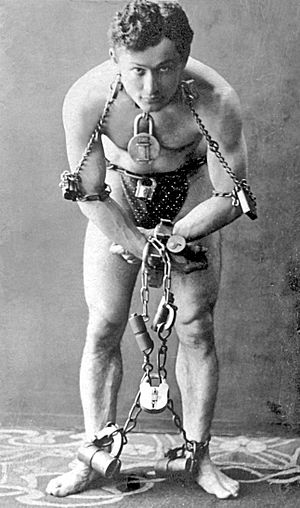Escapology facts for kids
Escapology is the amazing art of escaping from tricky restraints or dangerous traps. People who practice escapology are called escapologists or escape artists. They can free themselves from handcuffs, straitjackets, cages, and even underwater tanks! These performers often combine several challenges to make their acts even more exciting.
Contents
The Exciting History of Escapology
Early Escape Artists
For a long time, performers used escape skills in secret. They would free themselves from ropes or chains to make other magic tricks, like disappearing acts, seem more real. In the 1860s, the Davenport Brothers were famous for escaping from rope ties. They used these skills to make people believe they were communicating with spirits.
Later, other magicians like John Nevil Maskelyne figured out how the Davenport Brothers did their tricks. They showed that these were clever illusions, not real spirit powers. But it wasn't until about 30 years later that escaping became a main act itself.
Harry Houdini: The Master Escapologist
The most famous person to make escapology a popular show was Harry Houdini. He became a legend by escaping from all sorts of restraints and dangerous situations.
Houdini was open about being an expert in locks and how to get out of them. However, he kept the exact secrets of his escapes hidden. This helped keep the mystery and excitement alive for his audience. Many of his escapes used skills like lock-picking and being very flexible. He also performed big stage illusions. These tricks relied on clever props and designs.
Houdini's amazing acts set the standard for escapology. He famously escaped from handcuffs, padlocks, straitjackets, mail bags, and even prison cells. Even today, many great escape artists are called "modern-day Houdinis" because of his lasting influence.
What is a Predicament Escape?
A predicament escape is a type of magic trick where an escape artist seems to be in a very dangerous situation. They must then escape from it. A famous example is the Upside Down Suspended Straitjacket escape. In this act, a performer hangs high in the air from a burning rope and must escape before it breaks.
Sometimes, these escapes are designed to make it look like something went wrong. For example, in 1987, magician Paul Daniels performed a trick on his TV show. He was chained inside a special device where parts were set to close on him. The show made it seem like the parts closed before he escaped. Later, it was revealed he was safe, and the trick was meant to surprise the audience!
Amazing World Records
Escapologists often try to set new records. In 2012, Lucas Wilson, a Canadian illusionist, set a world record. He performed the fastest escape from a straitjacket while hanging upside down. He freed himself in just 8.4 seconds! He was suspended by his ankles at a height of 1 meter during this incredible feat.
Escapology in Books and Movies
Escapology is such an exciting art that it often appears in stories!
Harry Houdini on Screen
- The 1919 film The Grim Game starred Harry Houdini himself. He played a young man who had to escape many times after his fiancée was kidnapped. This film was lost for over 90 years but was found again in 2015 by escape artist Dorothy Dietrich.
- The 1953 movie Houdini showed many of his famous performances. Tony Curtis played the role of the legendary escape artist.
Superheroes and Escapes
- In superhero comic books, many heroes like Batman know escapology. This skill helps them get out of dangerous traps set by villains. Some superheroes, like Mister Miracle and The Escapist, are even professional escape artists!
Modern Movies with Escapology
- The 2006 movie The Prestige tells the story of two magicians who compete with increasingly difficult escape illusions.
- In the 2013 film Now You See Me, Isla Fisher plays an escape artist named Henley Reeves. To prepare for her role, she studied the work of real-life female escapologist Dorothy Dietrich. Dorothy Dietrich is famous for being the first woman to catch a bullet with her teeth!
List of Famous Escape Artists
- Harry Houdini
- David Copperfield
- Doc Cunningham
- Alan Alan
- Antony Britton
- Dean Gunnarson
- Frank Reno
- James Randi
- Norman Bigelow
- David Merlini
- Bill Shirk
- Dorothy Dietrich
- Criss Angel
- Michael Griffin
- Kristen Johnson
- Jonathan Goodwin
- Roslyn Walker
- Major Zamora
- Gopinath Muthukad
- Johnny Strange
- Paul Cosentino
See Also
 In Spanish: Escapismo para niños
In Spanish: Escapismo para niños
- Illusionist
- List of magicians
- Stunt performer


